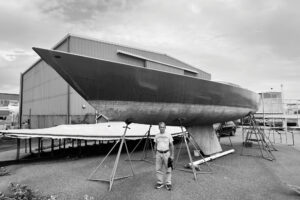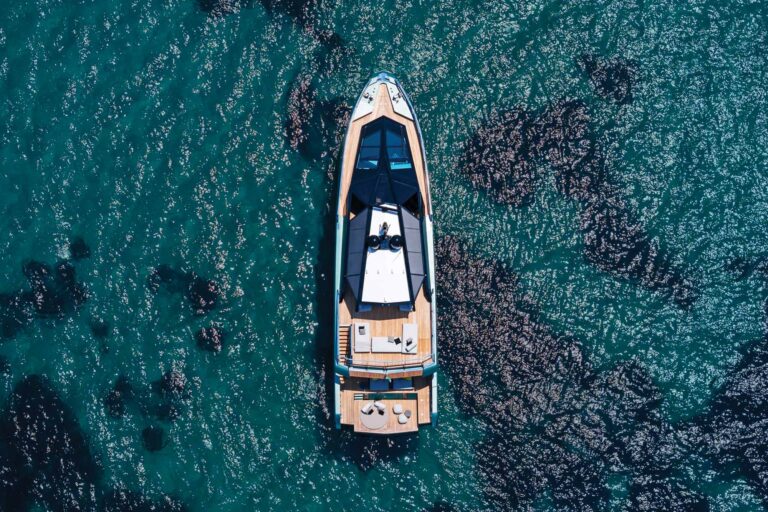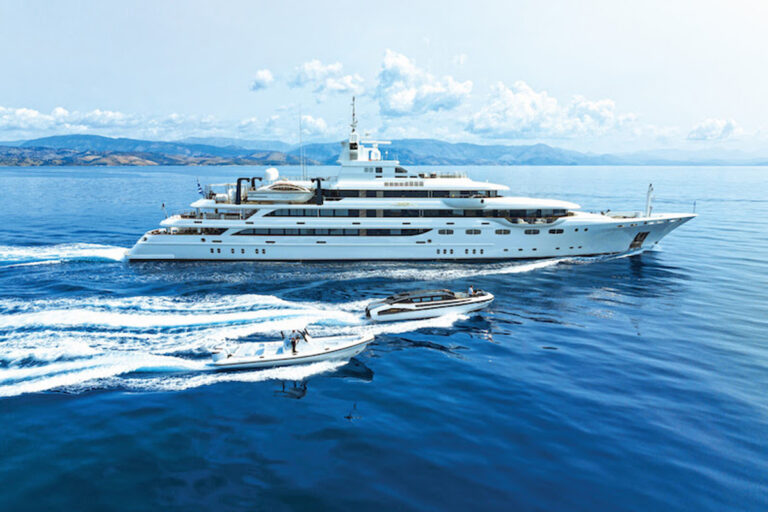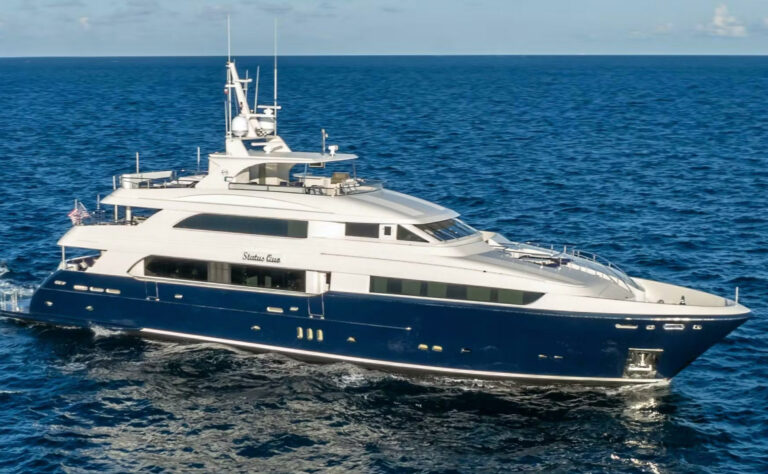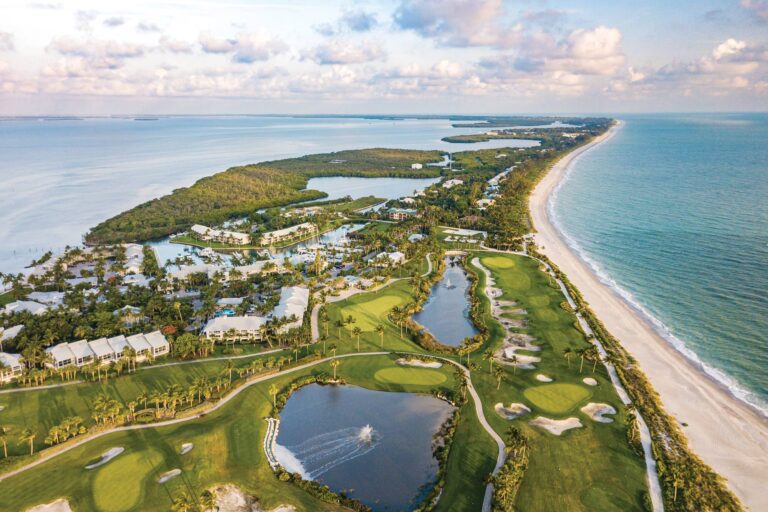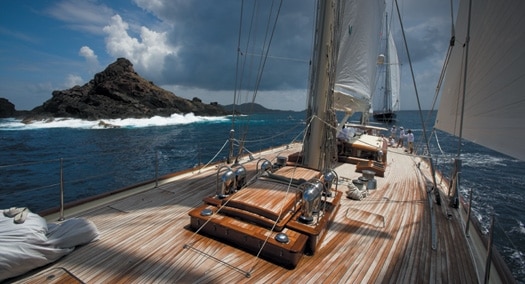
Bucket
What would you do if you built a 100-plus-foot sailboat, flew your crew of 20 or 30 down to the Caribbean to race her in the St. Bart’s Bucket, rented a lovely villa, lined up an America’s Cup vet as skipper, bought a new suit of sails (another $100K), and there was no wind?
On Saturday, April 1st, more than two dozen of the world’s largest and most beautiful sailing yachts were sitting dead in the impossibly blue waters of the Caribbean. A small cluster of yachts was gathered at the last turning point, two small rocky islands. Aboard Ghost, the sleek 122-footer created by former Wally designer Luca Brenta, Tom Whidden (Dennis Conner’s former tactician) was desperately trying to fill the giant headsail. Just a few boat lengths ahead, aboard the J-Class yacht Ranger, America’s Cup helmsman Ken Read was putting the crew of 35 (that’s right, crew of 35!) to work raising spinnakers, dropping the genoa, then raising the headsail again as zephyrs moved around the compass rose like the minute hand on a wristwatch.
Elsewhere, the five Perini Navis officially entered were scattered around the course. Though their sails were still up and in “race” mode, aboard the 178-foot megalith Parsifal III guests were reclining in the lounge chairs on the aft deck. A sixth Perini also mysteriously appeared: Rupert Murdoch had bandited the race, unofficially sailing his spanking new 184-foot Rosehearty across the line. She was now milling with the rest of the fleet, wondering from what direction Aeolus might exhale. At 3:30, Antara, the 151-foot Perini, was just 200 yards from the finish, almost close enough to the committee boat to hear ice tinkling in the cocktail glasses. There was so little wind, Antara had started to drift backwards. She dropped anchor. At 5 p.m. the race was abandoned.
Bankers had come from Zurich, filmmakers from Los Angeles, art dealers from New York and financiers from Rio de Janiero to race their boats in the Bucket. Now, for the second time in two days, the wind had evaporated leaving $600 million worth of yachts flapping in the well, just flapping. Suddenly 30 of the world’s wealthiest people found themselves helpless in the face of the one thing that no amount of money or power can control: Mother Nature. It was like a bad April Fool’s joke.
But then again, the Bucket is all about jokes. That morning, the crew aboard Ranger got a call from owner John Williams about a change in the crew uniform. Williams, who had built the 137-foot Ranger from the lines of Harold Vanderbilt’s 1937 America’s Cup defender, is known for his nothing-but-the-best taste. So the crew was somewhat puzzled when they were instructed to change out of their usual natty red-and-white Line 7 uniforms and don turquoise shirts, red shorts and lime green hats. People on the docks began to smirk. “The less said about the uniforms today, the better,” growled Capt. Ben Cameron as the crew scrambled to change into their new duds before the owner arrived. Then someone noticed Williams’ dinghy motoring over from his chartered 180-foot Benetti, Altitude, berthed on the other side of the harbor. He was wearing the classic red and white. “You guys look terrible,” said an impish Williams, as he climbed on board. “April Fools!”
Nelson Doubleday Jr. might have appreciated the prank.† The publishing magnate and former New York Mets owner helped start the Nantucket Bucket back in 1986. The first Bucket was dreamed up over† rum drinks by the captains of three of the largest sailing yachts of their day: Doubleday’s Mandalay, Volador and Peter Goldstein’s Flying Goose. Tom Taylor jumped in with the 108-foot Gleam and a total of seven boats competed. No one remembers who won that first race (the trophy was an actual bucket), but everyone remembers the parties that ensued. “The race was always around Nelson’s birthday and afterwards there was a clambake for about 200,” sailmaker Robbie Doyle recalls. In later years, Doubleday moved the party to his chic Nantucket restaurant, 21 Federal Street.
At one post-race, the band played all night long. “I got to Mandalay the next morning to go out racing and saw the drummer and the bass player carrying an amplifier across the lifelines,” says Ian Craddock, who later became Mandalay‘s captain. “It took me a minute to realize that Nelson intended to have the band play aboard during the race. As much fun as he liked to have,† it was blowing stink and we finally convinced him it might not be such a good idea.”
“We always tried to keep that sense of fun,” said Craddock, who took on running the events along with Capt. Tim Loughridge and Northrop & Johnson broker Hank Halsted. One year, the races began on the beach in Colombier harbor, a Le Mans start with the captain and owner downing a shot of rum, then taking the dinghy out to the yacht and sailing her off the anchor. “To finish, you had to do the reverse. That got a little dangerous,” Craddock recalls. “Imagine all these large yachts sailing through the anchored cruising boats to their dinghies, then the dinghies roaring up to the beach. I remember Sariyah’s inflatable hitting the beach at full throttle sending the owner, Saudi businessman Isam Kabbani, shooting out of the boat onto the sand.” That was the first and last such race.
Other traditions, such as the yacht hop, live on. On Friday night of this year’s event, the yachts with their illuminated 18-story-high masts lit up Gustavia’s harbor like the New York skyline. Sixteen Brobdingnagian yachts were docked stern-to at the Capitainerie, each hosting an open house for the other racers. Canadian developer Ron Joyce had flown in 60 live lobsters from Nova Scotia on his private plane and served them grilled aboard his 92-foot Destination Fox Harbour. Hap Fauth turned his 117-foot Whisper into a disco. For defending champion Sam Byrne, 43, owner of the 125-foot S&S Freedom of Flight, the yacht hop was a continuation of a party that had begun by the infinity pool at his rented hilltop villa the night before.
For Saturday night, there was to be a soiree for the owners hosted by sponsor Ralph Lauren and David Ray, the debonair owner of Newport’s Clarke Cooke House, at Ray’s new villa overlooking the harbor. As one sailor put it, “This isn’t a regatta, it’s a three-day party with sailing instructions.” The written sailing instructions were quite explicit in supporting this notion: Protests will be frowned upon. However, a protest will be heard if accompanied by a chilled case of champagne. (The quality of the champagne may improve the chances of a successful outcome.)
A case of champagne did show up addressed to the rating committee, which has the seemingly impossible task of figuring out how yachts such as the 1931 gaff-rigged Fife schooner Altair could compete against something like the composite/titanium wonder Visione, a boat Plattner calls “a pure racing yacht with five tons of furniture.” Jim Teeters, the rating guru, figured out how to handicap them and gave each yacht its own start time, the slowest yachts starting first with the goal of having boats converge on the finish. As long as it blew over 10 knots, the system more or less worked. So much so that at one finish in the 2005 Bucket, the S&S design Sariyah, the classic Fife Mariella and Perini Andromeda La Dea all finished within 40 seconds of each other.
Though the race committee made a point each of noting that bribes would be entertained if someone was truly unhappy with the rating, few ever came through with complaints. This year, the race’s limit of 30 entries was filled by January, with two left on the waiting list. With so many powerful people competing, the committee had learned the secret to keeping them happy: “We treat the owners like dirt,” said Halsted, grinning.
Peter de Savary, the former America’s Cup helmsman and the Brit who founded the St. James’ Club, The Abaco Club and Newport’s Carnegie Abbey, among others, concurs. As he sat aboard his 103-foot Rogue, he noted: “You have all these high-powered owners, and the committee just takes the piss out of them by openly saying such things as they accept bribes and if you win one year, they’ll make sure you don’t win again.” De Savary, who had survived a plane crash in St. Bart’s 17 years earlier that had killed his pilot, looked around the harbor and sighed, “How could anyone complain? We are all very, very fortunate people. Just look at all of this.”
Indeed, even in chichi Gustavia, where A-listers such as David Letterman and Uma Thurman were strolling the docks, the Bucket contenders were objects of envy. Two years earlier, Michael Gooch, the 46-year-old founder of the Wall Street firm GFI Group, had been one of the spectators. He was in St. Bart’s for his 20th wedding anniversary and, though not a sailor, was drawn to the scene. “All those big beautiful boats… and this event looked like so much fun,” he says. Last November he bought the 15-year-old Antara at the Ft. Lauderdale Boat Show.
As it turned out, Antara was the closest any yacht got to the finish line over the three-day event. Friday’s race was cancelled when the time limit ran out and the wind faded early on Sunday. But the awards went on and Gooch cleaned up: First there was the Perini award, for the best performance, then there was the Spirit of the Bucket award given by Churchill Yacht Partners. And then there was the Bucket itself.
After some head-scratching as to how to award a prize for a regatta with no finisher, the committee decided to go give it to the best starter, the yacht that had lost the fewest number of seconds crossing the start line. Surprisingly, the yachts with the race pros aboard were nowhere in the running. And Antara, with Gooch and his cruising captain, “Johnno” Johnston, and Dirk Johnson losing only 18 seconds getting across the two starts, took home the antique silver spittoon that replaced the original bucket. Second place went to filmmaker Joe Pytka (the director of Space Jam and Nike ads) who had just bought his first sailboat, Altair. Third went to Visione.
There were other awards too. Dutch yard owner Alice Huisman presented her “spirit” award to Betty Knox, who had come from Alberta, Canada, to look after her grandchildren aboard her son-in-law Mark Byrne’s Perini Perseus. Holland Jachtbouw presented the crew award to Capt. Mike “Sparky” Beardsall and the crew of the J-Class yacht, Endeavour, whose owner, Dennis Kozlowski, was doing time upriver for some improprieties involving his former company, Tyco. And the Escargot award-a can of snails that traditionally goes to the slowest in the fleet-went to the race committee itself.
The committee (Craddock, Halsted, Loughridge, Teeters and chairman Alessandro Vitelli) gleefully accepted the award from themselves, as the crowd held up glasses of Möet & Chandon in a toast. As Halsted noted, “We worked very hard to earn this.”




